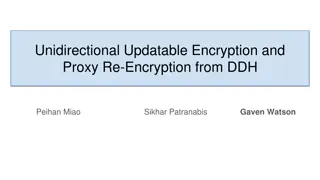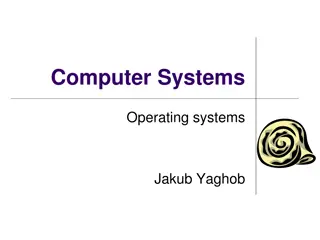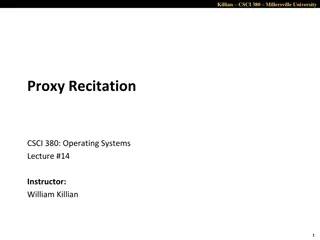Web Proxies and Proxy Architectures
Web proxies play a crucial role in networking by facilitating web requests between clients and servers. They come in various types such as forward proxies, reverse proxies, and open forward proxies, each with unique functionalities like content filtering, translation, and load balancing. This article explores different proxy architectures and their benefits in network services.
Download Presentation

Please find below an Image/Link to download the presentation.
The content on the website is provided AS IS for your information and personal use only. It may not be sold, licensed, or shared on other websites without obtaining consent from the author.If you encounter any issues during the download, it is possible that the publisher has removed the file from their server.
You are allowed to download the files provided on this website for personal or commercial use, subject to the condition that they are used lawfully. All files are the property of their respective owners.
The content on the website is provided AS IS for your information and personal use only. It may not be sold, licensed, or shared on other websites without obtaining consent from the author.
E N D
Presentation Transcript
Web Proxies COMP3220 Web Infrastructure Dr Heather Packer hp3@ecs.soton.ac.uk
Web Proxy Architecture A web proxy is a network service They receive web requests from clients and make requests on their behalf to web servers A web proxies behaviour differs depending on their function 3
No Proxy 4
Forward Proxy P 5
Forward Proxy Content Filtering P Restricts requests that can be made via proxy Outgoing URLs matched against list of blocked sites Response can be scanned Unwanted content Malware 6
Forward Proxy Content Translation P Transform responses Reduce bandwidth usage by client Commonly used by mobile phone networks Recompress images at lower resolution Minimising html, css and javascript Inject content into web pages eg adverts 7
Open Forward Proxy - Access Services Anonymously P Client accessing website via proxy: Masks their IP address Modifies their location (via GeoIP) Improve anonymity Defeat geo-blocking 9
Reverse Proxy P 10
Reverse Proxy Load-balancing P Distributes incoming web requests to a pool of web servers (targets) Performance and availability Many strategies including: round robin, weighted round robin Health checks ensure resilience 11
Reverse Proxy Content Switching static P html Examine incoming request and direct traffic to specific web servers Host or path based eg: https://example.com/static -> static webserver Incoming IP address, cookie or user-agent api 12
Reverse Proxy Protocol Translation P HTTPS SSL/TLS off-loading (OSI Layer 6) Incoming web requests over https, internal communications via http HTTP/2 to HTTP/1.x (OSI Layer 7) IPv6 <-> IPv4 (OSI Layer 3) 13
Reverse Proxy Monitoring and filtering P Monitor incoming requests Access logs / statistics Filter incoming requests Check security credentials (eg valid API tokens) Rate limit requests Intrusion detection and handling DDoS attacks Applying security policies (WAF) 14
Learning outcomes Many different types of proxies are deployed on the Web Different proxies are deployed for different purposes 15























